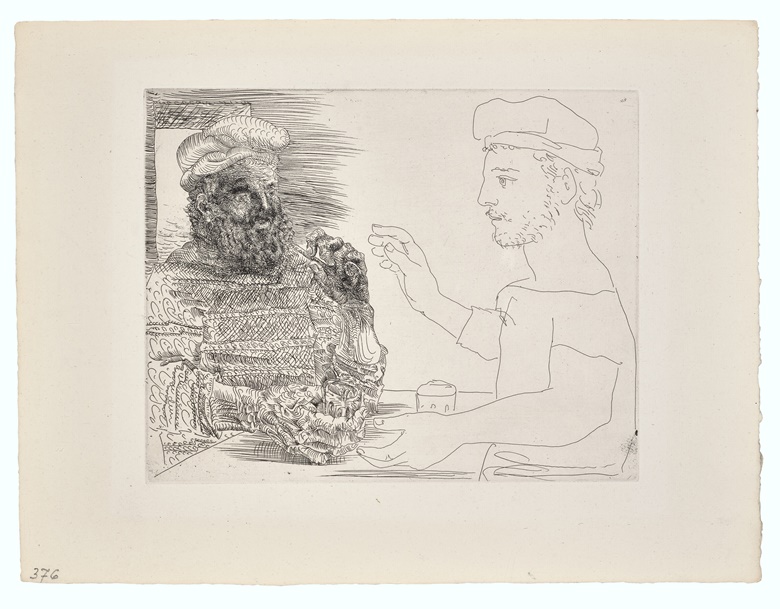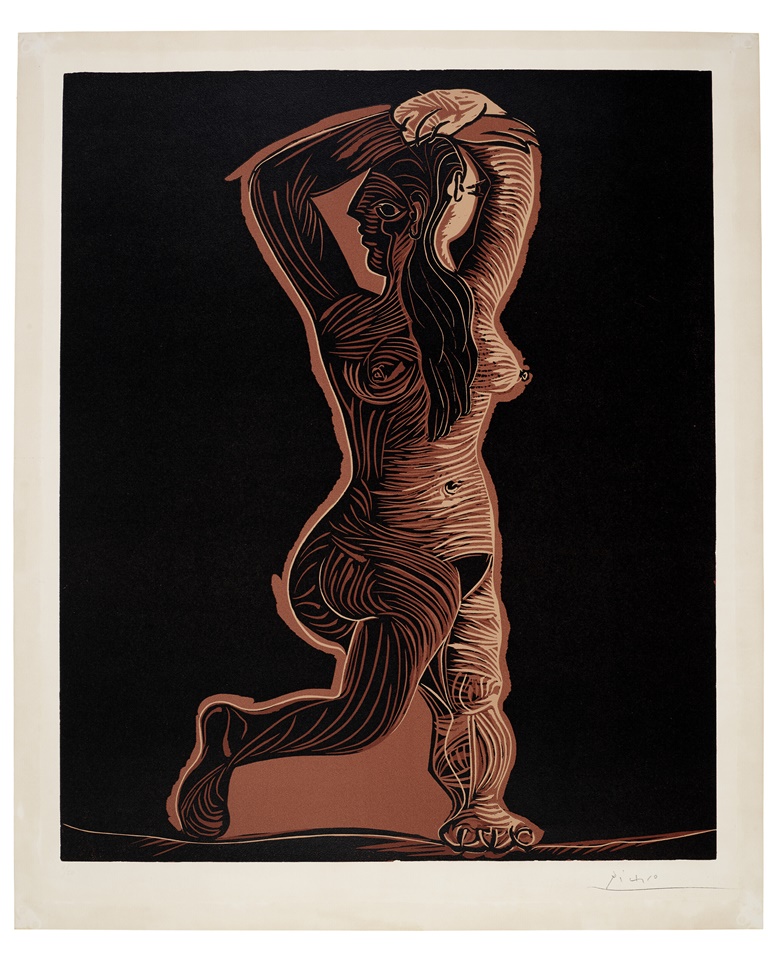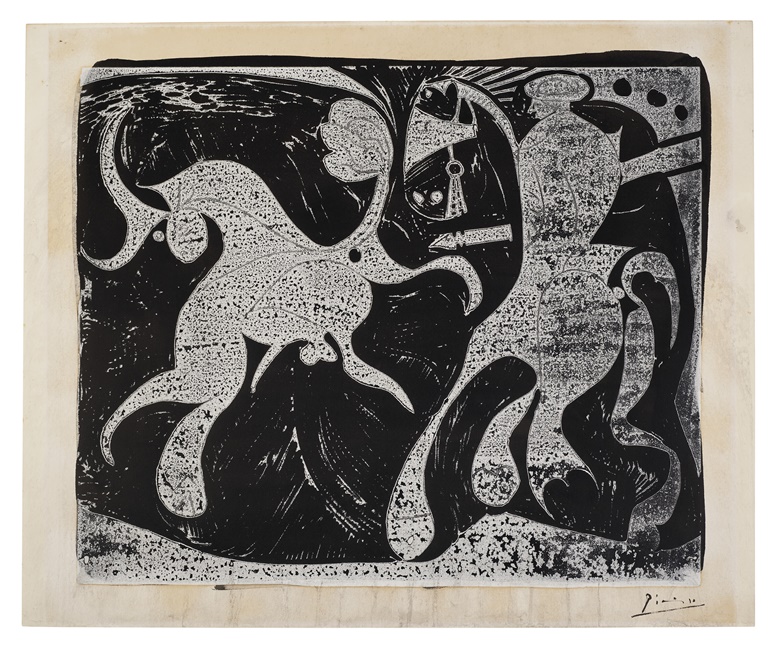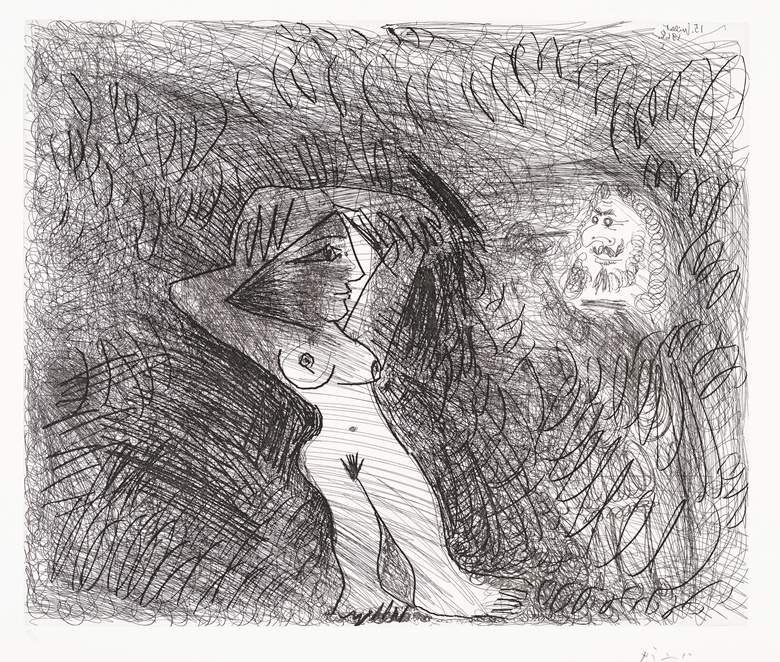Can I Use a Print of a Picasso on Art That I Am Selling
Picasso'southward prints: An practiced guide
Murray Macaulay, Head of Prints & Multiples at Christie's in London, explores the creative person's 7 decades of printmaking and explains why his etchings, lithographs and linocuts are as sought-after as e'er
Pablo Picasso (1881-1973) is about famous for his paintings, of course. The by decade, though, has seen a articulate growth in the market for his ceramics and especially his prints. In March 2022, Le Repas Frugal set a globe record for the price of a Picasso print when information technology fetched £6,014,500 at Christie's in London, as well making it the most expensive print ever sold at sale.
Picasso made prints throughout his career — his first in 1899, when he was still a teenager; his last in 1972, when he was 90. Experimenting all the while, he produced some 2,400 prints in total, in a wide variety of techniques, most notably carving, lithograph and linocut.
Printmaking, unlike painting, is a collaborative process, and over the decades Picasso worked with, and took instruction from, the masters of a host of different press ateliers. These included the lithographer Fernand Mourlot, who spoke of the creative person'southward restless marvel and how 'he looked, he listened, did the reverse of what he'd learnt — and remarkably information technology worked!'
.jpg?w=780)
Picasso's approach to making images was multi-disciplinary. Judging from the time and energy he spent making prints, it was just as of import a creative process for him equally painting. He would frequently work out ideas simultaneously in paint and print. A case in point is La femme qui pleure, I, above, where the carving pre-dates the famous painting of the aforementioned subject,Femme en pleurs.
'I retrieve there's a wider appreciation of Picasso's genius as a printmaker,' says Murray Macaulay, Head of Prints & Multiples at Christie'south in London. 'The chronology of his career is usually told through his relationships with different women or through the innovations of his painting style — Blueish menstruum, Rose period, and and so on — but you could also nautical chart these developments through the lens of his prints. The results were often but as extraordinary.'
Early experiments: The Saltimbanque Suite, Ambrose Vollard
Picasso began making prints in hostage in 1904-05, with a set of xiv etchings loosely on the theme of circus figures. This is known as his 'Saltimbanque Suite' and seems to take been made, principally, to make the impoverished artist some money.
The works went largely unnoticed, though, until the fine art dealer Ambroise Vollard prepare optics on them six years later. Having bought the plates from Picasso, he published them in editions of 250 each.
That was an unusually big number and revealed the faith Vollard had in his protégé. Information technology was such a large number, in fact, that the dealer had the plates steel-faced (coated with a sparse layer of steel) to forestall them from wearing out.
The Saltimbanque Suite includes 1 of Picasso'southward most famous prints, Le repas frugal, depicting a starving man and woman at a near-empty dinner table. He puts his arm effectually her, even so they look in opposite directions.
.jpg?mode=max?w=780)
The initial proofs from Saltimbanque, printed prior to Vollard's acquisition of the plates and earlier steel-facing, are some of the well-nigh sought-subsequently of Picasso's print oeuvre, and fetch significantly higher prices than the standard edition. Although steel-facing made the plates more robust to print from, in that location was a tangible diminishing of quality due to the process, with the loss of subtle etched details and textures. The earliest examples retain what Macaulay calls 'all the original atmosphere'. In 2022, one such print of Le Repas frugal from the collection of Heinz Berggruen, sold for £6,014,500 at Christie'south in London – making a new record price for any impress.
Co-ordinate to the specialist, Picasso's typical arroyo to prints saw him 'working intensively in a given technique for a period, developing a close relationship with a detail printer, innovating new means of working, then moving on'.
1930s: Roger Lacourière and the Vollard Suite
Among Picasso'south early experiments was the apply of unusually large carving needles, as well as the introduction of suet and nail varnish to try to achieve novel results.
Ane of his most successful advances came after starting work with Roger Lacourière in 1934. The artist adopted a procedure known as the 'sugar-lift aquatint', which involved the utilise of a sugary solution that created tonal, painterly effects — such as those visible in Faune devoilant une femme (Faun Unveiling a Sleeping Adult female) .
That piece of work was one of 100 etchings in the 'Vollard Suite', perhaps Picasso's best-known prints serial. The series was named after Ambroise Vollard, for whom it was produced, between 1930 and 1937 — in substitution for a pair of paintings the dealer owned by Renoir and Cézanne.

The suite features a number of Picasso alter egos — disguised sculptor, horned satyr, brutish minotaur — in a variety of interactions with a voluptuous girl. Inspiration came from the artist's new relationship with his young lover, Marie-Thérèse Walter.

With its fine, linear style, the Vollard Suite complements Picasso's paintings from the time — his so-chosen Neoclassical period. Information technology was published in an edition of 310. Consummate sets today are rare, but many private images are recognisable in their own right, such asMinotaure aveugle guidé par une Fillette dans la Nuit.
Post-1945: Fernand Mourlot, lithography and The Bull
After the Second Globe State of war, with Paris newly liberated, Picasso found himself bombarded by visitors. He sought refuge in the studio of lithographer Fernand Mourlot, located in an unfashionable role of the metropolis near Gare de 50'Est. There began another biggy creative person-printmaker partnership. The upshot was some 400 lithographs, the high points including portraits of Picasso's latest lover, Françoise Gilot.

Amongst his innovations was using his fingers to make marks instead of a brush or lithographic crayon. Picasso too liked the way lithography — more other printmaking processes, and certainly more than painting — allowed him to easily erase, rework and amend an image as he went along. 'The movement of my thought interests me more than the thought itself,' he said.
.jpg?w=780)
The prime example came with 'Le Taureau', an 11-lithograph serial made between December 1945 and January 1946. For this, Picasso made a succession of images of a balderdash, each one edifice on the one before, with Mourlot taking impressions along the style.
We witness the animal first grow into a massive animate being, and so end up as just a few schematic lines. The bull'due south development over xi prints allows us the rare privilege of tracking Picasso'southward creative process.
1950s: Hidalgo Arnéra and linocut
In the 1950s, Picasso moved to the Côte d'Azur. Carving and lithography were harder to practice there, as both involved specialist equipment which wasn't readily available.
Earlier long, however, the artist met a local printer chosen Hidalgo Arnéra, who specialised in posters — and who introduced him to the linocut process.
This usually entailed cut separate pieces of linoleum for each colour one wanted to utilize. Picasso, notwithstanding, plant a mode effectually this past inventing what became known as the 'reduction method', involving the use of just a unmarried piece of linoleum.

Picasso and Arnéra collaborated for the best office of a decade, always with the same routine: the creative person creating late into the night; having his chauffeur drive his work to Arnéra'south workshop beginning thing the next morning; Arnéra press the linocut; and so returning it to Picasso at 1.30pm for assessment.
The printmaker said the Spaniard 'had a sort of aggressive please in encountering an obstacle and surmounting information technology. Difficulty gave him a jumping-off point from which to conquer fresh fields'. The linoleum works are characterised by their wonderfully rich colours and bold patterning.

1960s: Aldo and Piero Crommelynck and the 347 Suite
In 1963, the printmaking brothers Aldo and Piero Crommelynck then wanted to work with Picasso that they upped sticks from Paris and ready an carving studio in the village of Mougins, where he was living at the time.
With the Crommelyncks' help, Picasso came to produce hundreds of etchings that count non just as a terminal hurrah, but as amid the finest of his career.

They include the 1968 series known as the '347 Suite': named after the number of etchings in information technology and produced past Picasso, aged 86, in a remarkable flare-up of intense working. 'I take less and less time,' he told Françoise Gilot, 'and yet I take more and more than to say.'
The images reveal, with some frankness, the erotic fantasies of an sometime man lacking the vigour of years past. The 347 Suite acquired a scandal when exhibited at the Fine art Institute of Chicago: information technology was accounted pornographic and the exhibition was closed downwardly.
.jpg?mode=max?w=780)
Showing zero diminution of his powers, Picasso worked on his final series, the '156 Suite', subsequently turning 90 — completing it in June 1972, less than a twelvemonth before his decease.
A life in printmaking
Picasso's career equally a printmaker lasted more than vii decades and is marked by innovation that Macaulay goes so far every bit to phone call 'iconoclasm'.
Like his paintings, his prints can to a large extent be interpreted autobiographically. His lovers and wives characteristic regularly, as sometimes do the politics of the twenty-four hour period, such every bit in the pair of prints lampooning General Franco, Sueño y Mentira de Franco I & Ii.
.jpg?w=780)
It tends to exist etchings that sell for the highest prices — above all, La femme qui pleure, I; Le Repas Frugal; and the vivid Minotauromachie, which was never published formally but reserved by Picasso for 55 close friends and patrons.
Macaulay, nevertheless, cautions against investing in the artist's prints on those terms. 'My advice for any potential buyer is, beginning and foremost, to find an paradigm you similar,' he says. 'There are recognised masterpieces by Picasso from all periods, in all techniques, and then you can't really go incorrect by post-obit your taste'.
Sign upwards today
Christie's Online Magazine delivers our best features, videos, and auction news to your inbox every week
Subscribe
'Exceptional artworks tin can be bought for well under £100,000 — such every bit, say, the etching and aquatintVénus et 50'Amour d'après Cranach or the lithograph Jacqueline de profil à droite ,' says Macaulay, 'and there aren't many markets you tin say that virtually.'
mejoradowinstral2000.blogspot.com
Source: https://www.christies.com/features/Picasso-prints-guide-10144-1.aspx
Belum ada Komentar untuk "Can I Use a Print of a Picasso on Art That I Am Selling"
Posting Komentar